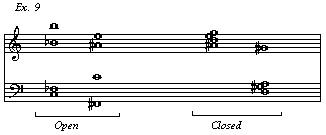UFPr Arts Department Electronic Musicological Review Vol. 1.1/September 1996 Home English
STUDY ON LOGIC PRINCIPLES APPLIED TO MUSICAL COMPOSITIONHarry L. Crowl
I. Introduction
In the present study, it is our intention to establish a coherent basis for the composition of one or more pieces of music from the same material.
The starting point for our proposition is the aim of creating an individual musical language as a composer of serious music.
Our attempt to develop such a language has been based in both Mediterranean and American musical culture, as well as the twelve-tone development by both Schönberg and Krenek, as it was introduced in Latin America by the Argentinean composer Juan Carlos Paz, through his Agrupación Musica Nueva, founded in Buenos Aires in 1937, as well as by the German composer H. J. Koellreuter, who immigrated to Brazil in 1939 and started his Movimento Música Viva in Rio de Janeiro in 1940. Both L. C. Paz and H. J. Koellreuter learned the twelve- tone technique from the musicologist and conductor Hermann Scherchen. These two musicians started working with such system even before the dodecaphonic method was known outside Vienna's musical circle. In fact, we find some few composers using that technique even before the formal treatise on serialism was published, which was Krenek's Studies in Counterpoint, edited in 1940, in New York. Some other attempts were made also by American composers to break with tonality before that was widely known in Europe. Such composers were Ives, Ruggles, Cowell and Copland.
At the present moment, almost 50 years later, many things have changed in the world of musical creation, such as the alleged denial of serialism, or of any formal system of atonality, or the return tonalism, or even to modalism. There is also, an infinite amount of information about musical systems from all civilizations and times from all over the world. So, it has become even more difficult for a composer to be original these days. In our case, we decided some time ago to choose a musical language that be coherent with a personal taste as well as with our historical background. With such an aim, we shall try to establish an organized system for the materials used in our compositions. Other elements used shall be taken from procedures observed in the religious musical tradition from Brazil and Portugal during the sixteenth, seventeenth, and eighteenth Centuries as well as elements from African and middle eastern cultures. All these elements shall be always quite diluted in the new musical idiom.
II. Organizing the Musical Material
Let's take an unusual interval from the tonal system, an augmented 4th (C - F#) and then, all noted comprised by that interval.
exemplo 1 In order to keep the interest on the melodic line, we will set these seven notes as follows:
exemplo 2 So, the sequence of intervals produced by that first set of notes shall be:
- 1/2 - augmented (ascending)
- 2/3 - Major 2nd (descending)
- 3/4 - Aug. 2nd (desc.)
- 4/5 - Maj. 3rd (asc.)
- 5/6 - Minor 3rd (desc.)
- 6/7 - Min. 2nd (asc.)
From the 7th to the 8th row's degree, we shall add the same augmented 4th to obtain 8th degree. Now, we have a sequence of eight notes where there are four missing ones to complete a twelve tone row.
Let's now apply the same intervals in a retrograde order, so we can find more different notes. By applying the same intervals in contrary motion, we find:
exemplo 3 Which means: Maj2nd (asc.), Aug2nd (asc.), Maj3rd (desc.), min3rd (asc.) and min2nd (desc.).
In this case, we find a high degree of repetitions which are not desired as it impoverishes the musical discourse. So, we shall now use another type of transposition. That is transposing the entire row one Aug. 4th up after the note A.
exemplo 4 In II. 4, we added the Aug. 4th to note A, and then, we repeated the same original sequence of intervals. That proved to be more satisfactory than transposing the retrograde row, as this one proved to bear very large degree of repetition.
In all transpositions, we end up with almost the same notes repeated and obtained no more than two ones, which coincidentally were A# and B plus a G. As one of the restrictions imposed here is the minimum of repetitions possible, we shall now organize the definite row as follows:
exemplo 5 The eleventh note was obtained through inverting the note's order of appearance in the series. That was done to keep more interest in the musical flow by avoiding a tonal sounding ascending minor 2nd.
As we now have an eleven-note row, let's call it "Original" (O). We shall now create the "inverted" row (I), as follows:
exemplo 6 From those two series, we will transpose them vertically, eleven times in a chromatic sequence:
exemplo 7 So, as we have now established all the horizontal references (we believe that this is a more appropriate way of defining it as the system in question is not a tonal or modal one), we could start any composition from this material without any risk of having that restriction of not having any interval wider than Aug. 4th not observed, regardless of what position either in the rows or in the transpositions we start and use throughout the piece. That is, of course, if we use strictly the sequence or notes comprised in those sets of rows.
The next step now is to establish the harmonic system that shall be used. In order to have an open selection of chords to be used, we shall draw them from the same series. But those chords must also be conceived under certain restrictions. We have determined them as follows:
All these possibilities may be used according to the expressive needs of any piece written from that material. To clarify what we mean by those definitions mentioned above, we shall give the following example:
1. Dissonant chords:

2. Opened/Closed

3. Sharp/Mild Dissonances

The present paper could be considered the starting point for the composition of our next three compositions scheduled, those are: a Concerto for Cello and Six Instruments, a Trio for Flute, Cello and Piano, and a Quartet for Piano, Violin, Viola, and Cello, commissioned respectively by the Ensemble Nord and Odense Ensemble, both from Denmark, and The George Crumb Trio, from Austria.
STOICA, Luana Irina. Generative Grammars and Musical Harmony. R.R.L. - C.L.T.A.,XXIV, 1. Bucharest: 1987. p.169- 179.
TURCU, Venera. Gramaticile generative Ale Melodicii Palestriniese. St. Cerc. Mat., Tom 30, Nr. 2. Bucharest: 1978. p.217-225.
CROWL, Harry Lamott. The Lamentations of the "Officium" Structure for an Extended Composition. Contemporary Music Review, 1995, Vol. 2, part 2. Chur: Harwood Academic Publishers. pp.93-108
KRENEK. Ernst. Studies in Counterpoint. New York: G. Schirmer Inc. 1940.
Graduated in English. Studied both violin and viola and composition at the Julliard School of Music in New York with Charles Jones and, more recently, Peter Sculthorpe in Dartington with a grant from the British Council.
His activities have been divided between composition and historical musicological research; he has been Lecturer at the Federal University of Ouro Preto since 1984, where he was the Head of the Music Department from 1986 to 1988, and from 1990 to 1992.
He has also lectured on Brazilian Art Music at the University of Texas at Austin, the University of Chile, Santiago, the Universidade Nova I, Lisbon, Portugal; and both at the Odense Musiskole and the Fynske Musikkonservatorium, Odense, Denmark. He is frequently invited to lectures at some of the most important festivals in Brazil. He is musicologist in residence at the Center for Eighteenth Century Studies, in Ouro Preto as well as Professor of Brazilian Music History at the School of Music and Fine Arts of Parana, Curitiba. (back)